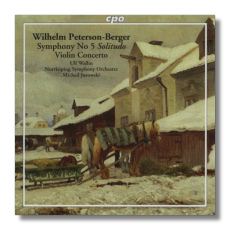
The Internet's Premier Classical Music Source
Related Links
- Latest Reviews
- More Reviews
-
By Composer
-
Collections
DVD & Blu-ray
Books
Concert Reviews
Articles/Interviews
Software
Audio
Search Amazon
Recommended Links
Site News
 CD Review
CD Review
Wilhelm Peterson-Berger

- Symphony #5 in B minor "Solitudo"
- Violin Concerto in F Sharp minor
Ulf Wallin, violin
Norrköping Symphony Orchestra/Michail Jurowski
CPO 999984-2 DDD 62:48
When an often harshly outspoken music critic also is a composer, his victims have a way of getting back at him. Such was the case with Wilhelm Peterson-Berger (1867-1942), whose education in far-off Dresden did not endear him to all of his fellow Swedes later on. "P.-B.," as he signed his newspaper columns, was bitten by the Wagner bug early in life, but did not slavishly imitate him in his music, which tends to be nationalistic, straight-forward (even conservative), but not lacking in imaginative ideas and unusual, attractive orchestration. The success of some of his larger works was no doubt inhibited by the many enemies he made. As a result, Peterson-Berger's greatest popular successes, at least in his lifetime, were smaller works which could be played by amateurs.
The Fifth Symphony is a late work, written between 1932 and 1933. Its subtitle suggests loneliness, and indeed, in 1930, Peterson-Berger left Stockholm and the politics and bitterness of its musical life, and retreated to the island of Frösö. The mood is more akin to Brahms ("Frei aber froh," perhaps?) than Mahler, however, and there is an appealing autumnal quality to the music. The composer seems to be looking back on the pleasurable things in life, namely friendships, and the natural beauty of Sweden. It is not uncommon for Peterson-Berger to save a surprise for the final movement of a large work. Here, it is an Allegro molto in tarantella rhythm. Despite the Italian seasoning, however, this remains a typically Scandinavian dish.
The Violin Concerto, composed in 1928, is one of Sweden's finest works in this genre, and it has been recorded several times. In length and form, it is not dissimilar to Tchaikovsky's violin concerto – a comparison Peterson-Berger would probably have deplored! The long first movement is full of nobility and passion. Then, there is a pastoral middle movement, directly followed by an exciting finale. Here, the surprise is the prominent use of the pentatonic scale. At the time, critics assumed that this was in some way related to the popularity of Puccini's opera Turandot. In fact, the finale sometimes has been described as a "Rondo in the style of Lapland." To my ears, the pentatonic writing gives the music a Native American quality – as if it had been Grieg and not Dvořák who had spent time in the American midwest!
I reviewed an earlier Peterson-Berger release from these performers, and complained a little about the quality of the playing. This time around I am completely satisfied. I think Jurowski and the Norrköping players make an excellent case for this music, and Wallin is an exciting and sympathetic soloist. (Nilla Pierrou's older recording, now on Phono Suecia, is not to be missed, however.) As is usually the case with cpo, the booklet notes are very detailed and educational – more than your money's worth, you might say. (Never mind that Peterson-Berger could not possibly have seen five performances of Die Meistersinger in 1987, except as a ghost!) Fine engineering, too.
Copyright © 2005, Raymond Tuttle




















